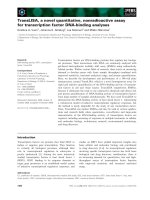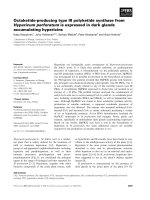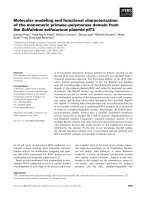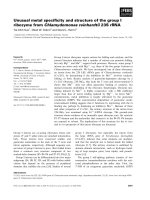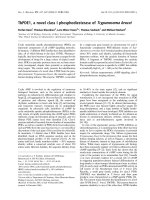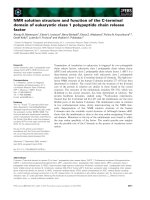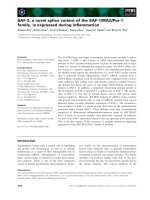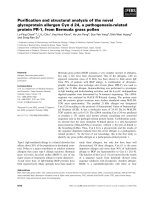Báo cáo khoa học: SAF-3, a novel splice variant of the SAF-1/MAZ/Pur-1 family, is expressed during inflammation pptx
Bạn đang xem bản rút gọn của tài liệu. Xem và tải ngay bản đầy đủ của tài liệu tại đây (1.6 MB, 11 trang )
SAF-3, a novel splice variant of the SAF-1/MAZ/Pur-1
family, is expressed during inflammation
Alpana Ray1, Srijita Dhar1, Arvind Shakya1, Papiya Ray1, Yasunori Okada2 and Bimal K. Ray1
1 Department of Veterinary Pathobiology, University of Missouri, Columbia, MO, USA
2 Department of Pathology, School of Medicine, Keio University, Tokyo, Japan
Keywords
gene expression; inflammation; SAF-1/MAZ/
Pur-1; splice variant; transcription factor
Correspondence
B. K. Ray, Department of Veterinary
Pathobiology, University of Missouri, 124
Connaway Hall, Columbia, MO 65211, USA
Fax: +1 573 884 5414
Tel: +1 573 882 4461
E-mail:
A. Ray, Department of Veterinary
Pathobiology, University of Missouri, 126
Connaway Hall, Columbia, MO 65211, USA
Fax: +1 573 884 5414
Tel: +1 573 882 6728
E-mail:
Database
The sequence for MAZ genomic DNA has
been submitted to the Genbank database
under the accession numbers D89880.
(Received 6 January 2009, revised 12 May
2009, accepted 5 June 2009)
The Cys2His2-type zinc finger transcription factor serum amyloid A activating factor 1 [SAF-1, also known as MAZ (myc-associated zinc finger
protein) or Pur-1 (purine binding factor-1)] plays an important role in regulation of a variety of inflammation-responsive genes. An SAF-2 splice variant acting as a negative regulator of SAF-1 was identified previously, and
the present study reports the identification of a novel SAF-3 splice variant
that is expressed during inflammation. SAF-3 mRNA, isolated from a
cDNA library produced from IL-1b-induced cells, originates from a previously unknown first coding exon, and thereby contains a unique N-terminal domain but shares the same six zinc finger DNA-binding domains as
present in SAF-1. In addition, a negatively functioning domain present at
the N-terminus of SAF-1 and SAF-2 is spliced out in SAF-3. The expression of SAF-3 is very low in normal tissues and in cells grown under
normal conditions. However, RT-PCR analysis of mRNAs from cytokine
and growth factor-induced cells as well of mRNAs isolated from several
diseased tissues revealed abundant expression of SAF-3. The transactivation potential of SAF-3 is much greater than that of the predominantly
expressed splice variant SAF-1. These findings show that transcriptional
regulation of downstream inflammation-responsive genes by SAF/MAZ/
Pur-1 is likely to be more complex than previously assumed. In addition,
we show that SAF-3 expression initiates from an upstream novel promoter.
This is the first report of the existence of multiple promoters regulating
expression of the SAF/MAZ/Pur-1 family of proteins.
doi:10.1111/j.1742-4658.2009.07136.x
Introduction
Transcription factors play a central role in regulating
cell growth and development as well as in cellular
maintenance as a result of their indispensable role in
synthesizing mRNA. Dysregulation of transcription
factor activity leads to alteration in target gene expression patterns, which is one of the most important
causes of disease development and progression. Exten-
sive studies on the characterization of transcription
factors have indicated that, in general, transcription
factors exist as a family of structurally related proteins,
containing conserved and unique domains. The family
members can perform similar tasks due to the conserved domains but may be functionally specific due to
the unique domains. The various members of the
Abbreviations
CAT, chloramphenicol acetyl transferase; GAPDH, glyceraldehyde-3-phosphate dehydrogenase; MAZ, myc-associated zinc finger protein;
MMP, matrix metalloproteinase; OA, osteoarthritis; Pur-1, purine binding factor-1; RA, rheumatoid arthritis; SAF-1, serum amyloid A
activating factor; VEGF, vascular endothelial growth factor.
4276
FEBS Journal 276 (2009) 4276–4286 ª 2009 The Authors Journal compilation ª 2009 FEBS
A. Ray et al.
family are often generated from a single gene by alternative splicing, which is recognized as an efficient
means of increasing the diversity of proteins.
Serum amyloid A activating factor 1 (SAF-1) is the
first identified member of a transcription factor family
containing multiple Cys2His2-type zinc finger proteins
[1]. The human and mouse orthologs of SAF-1 are
known as myc-associated zinc finger protein (MAZ) [2]
and purine binding factor-1 (Pur-1) [3], respectively.
The SAF-1/MAZ/Pur-1 transcription factor is an
inflammation-responsive protein, and regulates the
expression of a variety of genes that include serum
amyloid A [1,4], vascular endothelial growth factor
(VEGF) [5], p21 [6], several matrix metalloproteinases
(MMPs) [7–10], c-myc [2], insulin [3], and the serotonin
1A receptor [11], which are involved in diverse cellular
processes and various pathogenic conditions. A number of inflammatory stimuli such as cytokines [12],
phorbol 12-myristate 13-acetate [13], lipopolysaccharide [14] and oxidized low-density lipoproteins [15]
have been shown to activate SAF-1 protein and
increase its DNA-binding and transactivating functions. The SAF-1 DNA-binding and transcriptional
activity is significantly increased in response to mediators of signal transduction and phosphorylation by a
number of protein kinases [13,16,17]. The transcript
level of SAF-1/MAZ is also reported to be increased
in response to cytokine stimulation [18], in hepatocellular carcinoma [19], chronic myelogenous leukemia
[20] and acute myeloid leukemia [21], and during skeletal myocyte differentiation [22].
In a previous analysis, we identified SAF-2 [23], the
second member of this family, which is encoded by the
same gene by alternate splicing. Insertion of a new
exon originating from the non-coding sequences of
intron 4 of the SAF-1/MAZ gene resulted in creation
of a different C-terminus consisting of eight zinc finger
domains in SAF-2 [23]. The SAF-2 isoform has a
much higher DNA-binding activity and acts as a negative regulator of SAF-1 function under normal conditions [23]. During inflammation, SAF-2 expression is
down-regulated, which alleviates the repression of
SAF-1 activity and further promotes SAF-1-mediated
transactivation of the target genes [23]. In this paper,
we present evidence for a third member of SAF family,
which is also transcribed from the same gene but originates from an upstream novel start site and contains
an entirely different N-terminus. Expression of SAF-3
is restricted to inflammatory conditions. Further, we
present evidence that SAF-3 is much more transcriptionally active than SAF-1. These results shed light on
the relevance of the generation of multiple distinct
functional SAF isoforms, and imply the existence of
Transcription factor SAF-3 is expressed during inflammation
combinatorial mechanisms that allow fine regulation
by SAF-regulated genes.
Results
Identification and characterization of a novel SAF
isoform
Screening of an IL-1b-induced human HTB-94 chondrocyte cell cDNA library identified a novel human
SAF-1/MAZ/Pur-1 isoform that contains unique
N-terminal sequences (Fig. 1). This clone, with an
open reading frame of 455 amino acids, was designated
SAF-3 (GenBank accession number FJ532357), with
SAF-1/MAZ/Pur-1 being the originally identified isoform [1–3]. Comparison of amino acid sequences indicated that the N-terminal region of SAF-3 is different
from that of SAF-1, after which both cDNAs contain
identical sequences. The previously isolated SAF-2 isoform differs from SAF-3 at both the N- and C-termini
[23]. SAF-1 and SAF-2 have identical N-termini, but
the SAF-2 mRNA contains an unique exon near the 3¢
end, and thus its C-terminus is different from that of
SAF-1 [23]. The open reading frames in SAF-1, SAF-2
and SAF-3 code for 477, 493 and 455 amino acids,
respectively.
SAF-3 is produced by alternative splicing
To determine the presence of unique N-terminal
domain in SAF-3, we examined the genomic DNA
sequence of human SAF-1/MAZ/Pur-1 [24]. Sequence
analysis indicated that the unique N-terminal amino
acids of SAF-3 are encoded by a previously unidentified exon (exon 1A) that is present 351 nucleotides
upstream of the first exon of human SAF-1/MAZ
(Fig. 2A). The first exon in human SAF-3 (exon 1A)
encodes 12 amino acids, including the initiator methionine (Fig. 2B). The nucleotide sequence around the initiation ATG codon in SAF-3 matches the translation
initiation site consensus sequence as determined by
Kozak [25] (Fig. 2B). The second exon of SAF-3 (exon
1C) starts at around the middle of the first exon of
SAF-1/SAF-2. The SAF-3 transcript also represents an
in-frame splicing event, for which the open reading
frame remains unchanged. The 5¢ and 3¢ splice junctions of exons 1A and 1C match consensus splice
donor and acceptor sequences (Fig. 2C and Table 1).
The N-terminal amino acid sequences of three SAF
isoforms are shown in Fig. 2D. We performed primer
extension analysis to determine whether the SAF-3
cDNA contains a full-length 5¢ UTR. A 32P-endlabeled, 18-base antisense oligonucleotide primer was
FEBS Journal 276 (2009) 4276–4286 ª 2009 The Authors Journal compilation ª 2009 FEBS
4277
Transcription factor SAF-3 is expressed during inflammation
A. Ray et al.
Fig. 1. Analysis of a structurally altered
form of SAF. The nucleic acid and predicted
amino acid sequences of the cDNA encoding SAF-3 are shown. The initiator ATG
codon and stop codon are indicated.
4278
FEBS Journal 276 (2009) 4276–4286 ª 2009 The Authors Journal compilation ª 2009 FEBS
A. Ray et al.
Transcription factor SAF-3 is expressed during inflammation
F
A
E
G
B
C
H
D
Fig. 2. Schematic representations of SAF splice variants. (A) Exons are indicated by white boxes, and 5¢ and 3¢ UTRs by speckled boxes.
The introns and UTRs are not drawn to scale. The positions of the primers used for RT-PCR are indicated by bold lines. (B) Sequence of
exon 1A in SAF-3. The Kozak consensus sequence is indicated by a line above the sequence. (C) The exon/intron boundaries conform to
consensus splice junction sequences. (D) N-terminal amino acids of the SAF-1/SAF-2 and SAF-3 isoforms. (E) Primer extension analysis. A 5¢
end-labeled oligonucleotide complementary to a sequence near the 5¢ end of sequenced cDNA (+4 to +21 with respect to translation initiator
ATG codon) was used to prime cDNA synthesis using poly(A)+ RNA from IL-1b-induced HTB-94 cells (lane 2). The arrow indicates the major
primer extension product, and the arrowheads show minor primer extension products. As a negative control, yeast tRNA was used in separate extension reaction, and no extension product was produced (lane 3). Lane 1 contains a G-specific reaction of an unrelated sequence that
was used as a size marker to determine the length of the primer extension products. (F) RT-PCR analysis. Total RNA isolated from IL-1binduced HTB-94 cells was subjected to reverse transcription and nested PCR using SAF-3-specific (lane 1) and SAF-1-specific (lane 2) oligonucleotide primers. The amplified product was verified by direct DNA sequencing. (G) Bacterially expressed SAF-1 (lane 2) and SAF-3 (lane
3) proteins were fractionated by SDS–PAGE. The migration positions of these proteins in lanes 2 and 3 are indicated. Lane 1 contains proteins from vector-transfected cells. (H) In vitro transcription and translation. A linear plasmid containing full-length SAF-3 cDNA downstream
of T7 RNA polymerase transcription start sequences was subjected to in vitro transcription and translation. The protein products
were labeled with 35S-methionine, fractionated by SDS–PAGE and autoradiographed. Lane 1 contains no added DNA and lane 2 contains
SAF-3 plasmid DNA. The sizes of the protein products were identified using standard protein molecular weight markers.
Table 1. Sequences of exon/intron junctions in human SAF-3. Exon
sequences are shown in upper-case letters, and intron sequences
are shown in lower-case letters.
Exon
Intron
size
Exon (nt)
size
5¢ splice donor
(nt)
3¢ splice acceptor
1A
75 ATCTTCCAGgtaacaac
625
cacctcagGGTCACGCC
1C
87 CCATTCCAGgtgagtag
84
ctccgcagGCCGCGCCG
2
851 CTTCTCCCGgtgtgcac
403
gtccccagGCCGGATCA
3
64 AATGTGAGgtaggaag
277
ctcctcagAAATGTGAG
4
172 CAACAAAGgtacatgc
1335
ctgtgcagGTACTGGTG
5
1028
utilized for the primer extension reaction, and
indicated several possible transcription start sites for
SAF-3 mRNA (Fig. 2E, lane 2). However, the estimated length of the major primer extension product
corresponded well with the sequence of cloned SAF-3,
suggesting that this cDNA possibly contains a fulllength 5¢ UTR. The two faint but longer primerextended products that were visible in Fig. 2E, lane 2,
probably arise from other transcription start sites, and
are minor transcription products. Nested RT-PCR
analysis was performed for further verification of the
existence of novel exon 1A in SAF-3. A product of the
FEBS Journal 276 (2009) 4276–4286 ª 2009 The Authors Journal compilation ª 2009 FEBS
4279
Transcription factor SAF-3 is expressed during inflammation
right size was amplified from mRNAs of IL-1binduced HTB-94 cells using an upstream primer corresponding to the 5¢ untranslated sequences of SAF-3
and a downstream primer corresponding to the
sequences at exon 2 (Fig. 2F, lane 1). The identity of
the PCR-amplified product was verified by DNA
sequence analysis. The same downstream primer at
exon 2, together with an upstream primer corresponding to the SAF-1 sequence at exon 1B, produced an
SAF-1-specific PCR product (Fig. 2F, lane 2). The
translation product of SAF-3 cDNA was determined
by cloning SAF-3 cDNA in a bacterial expression vector (Fig. 2G). In line with the cDNA size, bacterially
expressed SAF-3 protein migrates slightly faster than
bacterially expressed SAF-1 protein in the same vector
(Fig. 2G, compare lanes 3 and 2). We performed a
coupled in vitro transcription and translation reaction
to further determine whether SAF-3 is indeed initiated
from the first ATG codon. The SAF-3 protein translated from the predicted ATG codon is 455 amino
acids long. The next ATG codon in the SAF-3 cDNA
is 603 nucleotides downstream of the first ATG codon,
and a protein initiated from this ATG would be of
considerable smaller size, containing 254 amino acids
and with an approximate molecular mass of 28 kDa.
As seen in Fig. 2H, lane 3, the in vitro transcribed and
translated protein product from SAF-3 cDNA was of
A
B
A. Ray et al.
similar size to that obtained using the bacterial
expression system, indicating that the major translation
product of SAF-3 mRNA is 455 amino acids long.
Inflammation-responsive expression of SAF-3
To determine the expression pattern of SAF-3, we
hybridized a multiple-tissue Northern blot with a
radiolabeled SAF-3-specific oligonucleotide probe (corresponding to exon 1A), and found no detectable
signal (Fig. 3A). However, upon re-hybridization with
a full-length SAF-1 cDNA probe containing sequences
common to SAF-1, SAF-2 and SAF-3, the same blot
showed the presence of multiple bands (Fig. 3B). As a
positive control for the SAF-3-specific oligonucleotide
probe, we prepared SAF-1 and SAF-3 RNA by in vitro
transcription and hybridized the RNA with radioactive
SAF-3 oligonucleotide probe. This probe clearly
detected in vitro transcribed SAF-3 mRNA but did not
detect SAF-1 mRNA (Fig. 3C). Together, these results
suggest very low SAF-3 expression in normal tissues.
Given that SAF-3 was isolated from a cDNA library
produced from IL-1b-induced cells, we examined the
status of this isoform during cytokine stimulation of
cells. RT-PCR of RNA isolated from untreated and
IL-1b-treated HTB-94 cells showed expression of a
detectable level of SAF-3 only upon cytokine induction
C
D
E
Fig. 3. Cytokine or growth factor treatment stimulates expression of SAF-3. (A) Northern analysis of an RNA blot (Clontech) containing 1.0 lg
of poly(A)+ RNA per lane from various tissues as indicated. The blot was hybridized using a 32P-labeled oligonucleotide probe containing
unique exon 1A sequences of SAF-3 mRNA. (B) The same blot was stripped and re-hybridized with a full-length 1.4 kb 32P-labeled SAF-1
cDNA probe. (C) SAF-1 (lane 2) and SAF-3 (lane 3) RNAs were in vitro transcribed from corresponding cDNA plasmids by T7 RNA polymerase.
Reaction products were fractionated in a 1% agarose gel, transferred to nylon membrane, and hybridized with a 32P-labeled oligonucleotide
probe containing unique exon 1A sequences of SAF-3 mRNA. Lane 1 contains HindIII-digested kcI857 DNA. (D) HTB-94 and Saos-2 cells
were treated with or without IL-1b (500 mL)1) or TGFb (5 ngỈmL)1), as indicated. Total RNA isolated from these cells was subjected to
reverse transcription followed by nested PCR amplification to monitor SAF-3 expression. The same sets of RNAs were also used to monitor
MMP-9 and GAPDH expression, as indicated. The PCR products were separated in a 1.5% agarose gel and visualized by ethidium bromide
staining. (E) Western blotting with SAF-3-specific antibody. One microgram each of purified bacterially expressed SAF-1 protein (lane 1) and
SAF-3 protein (lane 2) and 50.0 lg each of uninduced (lane 3) and IL-1b-induced (lane 4) HTB-94 cell extracts were fractionated by 11% SDS–
PAGE, transferred onto membrane and Western blotted with anti-SAF-3 serum. The arrow indicates SAF-3 protein in IL-1b-induced cells.
4280
FEBS Journal 276 (2009) 4276–4286 ª 2009 The Authors Journal compilation ª 2009 FEBS
A. Ray et al.
(Fig. 3D, lanes 1 and 2). SAF-3 was also detected in
TGFb-induced Saos-2 osteosarcoma cells (Fig. 3D,
lanes 3 and 4). As positive control, we examined the
expression of MMP-9, which is known to be induced
in HTB-94 cells by both IL-1b and TGFb. MMP-9
expression was detected in both IL-1b- and TGFbstimulated cells. As a control for the same input of
RNA in RT-PCR, the glyceraldehyde-3-phosphate
dehydrogenase (GADPH) expression pattern was monitored, and this remained unchanged during cytokine
induction. To detect in vivo expression of SAF-3, a specific antibody was generated utilizing the unique N-terminal peptide sequences. Western blot analysis was
performed to confirm the specificity of this antibody, as
it did not detect bacterially expressed SAF-1 protein
but clearly detected bacterially expressed SAF-3 protein
(Fig. 3E, lanes 1 and 2). SAF-3 expression was detected
at a low level in IL-1b-induced HTB-94 cells using this
antibody (Fig. 3E, lanes 3 and 4).
Detection of SAF-3 mRNA in chronic
inflammatory diseased tissues
Given the cytokine-responsive expression of SAF-3, we
examined its level in diseased tissues. Osteoarthritis
(OA) is a chronic inflammatory disease that involves
degeneration of the cartilage tissue, while rheumatoid
arthritis (RA) is a systematic chronic inflammatory
and destructive arthropathy. As seen in Fig. 4, SAF-3
mRNA expression was detected in OA synovial
(Fig. 4, lanes 3–6) and RA synovial (Fig. 4, lanes 7–9)
tissues, but very little to no SAF-3 mRNA expression
was detected in normal synovium (Fig. 4, lanes 1 and
2). SAF-1 expression was detected in normal tissues
and was slightly elevated in both disease conditions.
This result is consistent with previous findings indicating that the main mode of activation of SAF-1 is by
post-translational modification, including phosphoryla-
Fig. 4. SAF-3 expression is detected in human arthritic tissues.
Total RNA was isolated from representative normal, OA and RA
synovium tissues and subjected to RT-PCR using SAF-3-, SAF-1and GAPDH-specific primers, as indicated. GAPDH expression was
used as an internal control.
Transcription factor SAF-3 is expressed during inflammation
tion [13, 16, 17]. Together, these results indicated that
SAF-3 expression is very low and highly regulated
under normal conditions, but increases in response to
pathogenic signals and cytokine or growth factor
stimulation.
SAF-3 is a superior transcriptional activator
SAF-3 contains six zinc finger motifs, and should have
the ability to interact with DNA at a similar level to
SAF-1 [26]. However, because it contains a different
N-terminus, the transactivation potential of SAF-3
may be different, and it may thereby regulate expression of downstream genes at a different level. To
determine the functional significance of SAF-3, we
compared its transactivation potential with that of
SAF-1. The SAF-3 expression plasmid transactivated
expression of the SAF-3X-CAT reporter at a much
higher level than the same amount of SAF-1 expression
plasmid DNA (Fig. 5A). To rule out the possibility
that SAF-1 and SAF-3 proteins were not expressed at
the same level, we performed a Western blot assay
using an anti-His tag IgG and representative transfected cells (Fig. 5B). This experiment showed no
discrepancy in the expression of proteins, indicating
that SAF-3 is a superior transcriptional activator
compared to SAF-1. For further verification, we
compared ability of these two isoforms to transactivate
expression of VEGF, a natural SAF-regulated gene [5].
In correlation with previous results, the SAF-3
expression plasmid increased expression of the 1.2
VEGF-CAT reporter in a more effective manner
(Fig. 5C). Together, these results show that the SAF-3
splice variant has significantly higher transactivation
potential.
SAF-3 mRNA is transcribed from a distinct
transcription start site
An SAF-1/SAF-2-specific 5¢ RACE did not reveal any
upstream 5¢ sequences in SAF-3 (data not shown); this
suggests that SAF-3 and SAF-1/SAF-2 mRNAs may
be transcribed from distinct promoter regions. To
determine whether SAF-3 and SAF-1/SAF-2 mRNAs
are initiated from different promoters, we examined
the respective 5¢ flanking regions. Genomic DNA
sequences upstream of SAF-3 and SAF-1/SAF-2 were
ligated into the promoterless vector pBLCAT3 to
produce ()2000/+200)SAF-CAT, ()2000/)351)SAFCAT and ()351/+200)SAF-CAT reporter constructs.
Transient transfection of HTB-94 cells with these
reporters resulted in significantly higher levels of
chloramphenicol acetyl transferase (CAT) activity,
FEBS Journal 276 (2009) 4276–4286 ª 2009 The Authors Journal compilation ª 2009 FEBS
4281
Transcription factor SAF-3 is expressed during inflammation
A. Ray et al.
albeit variable, compared to cells transfected with the
promoterless pBLCAT3 vector (Fig. 6). These results
clearly indicate that the DNA sequences between
)2000 and )351 and )351 and +200 contain necessary elements that can promote transcription. We conclude from these results that the human SAF-1 gene
has at least two promoters.
A
Discussion
In this paper, we describe a novel splice variant of
SAF-1/MAZ/Pur-1 family of transcription factors that
may be involved in regulating inflammation-induced
expression of various SAF targets associated with
pathogenic conditions. In addition, we provide the first
evidence of the existence of two promoters in the
human SAF-1/MAZ/Pur-1 gene that permit transcription of multiple mRNAs with different N-termini. The
novel SAF-3 splice variant reported here is transcribed
from the upstream promoter. SAF-3 is predominantly
expressed in cytokine- and growth factor-treated cells
and in diseased tissues, but is barely detectable under
normal conditions.
B
C
A
B
Fig. 5. Transactivation potential of SAF-3. (A) HTB-94 cells were
co-transfected with SAF3X-CAT2 reporter plasmid (0.5 lg) and
pCMV-bgal expression plasmid (0.4 lg) without ()) or together
with (+) empty vector pcDNA3 (0.5 lg), pcDSAF-1 (0.5 lg) or pcDSAF-3 (0.5 lg) expression plasmid DNA, as indicated. After 24 h,
cells were harvested and equivalent amounts of cell extracts were
assayed for CAT reporter activity. The data shown represent the
mean ± SEM of three separate experiments (*P < 0.05 versus
control). (B) Western blot analysis of transfected cells with anti-His
tag IgG. (C) CAT reporter assay. HTB-94 cells were transfected
with 1.2VEGF-CAT reporter plasmid (0.5 lg) and pCMV-bgal
expression plasmid (0.4 lg) without ()) or together with increasing
concentrations (0.2, 0.3, 0.4 and 0.5 lg) of pcDSAF-1 or pcDSAF3 expression plasmid DNA, as indicated. After 24 h, cells were
harvested and equivalent amount of cell extracts were assayed for
CAT reporter activity. The data shown represent the mean ± SEM
of three separate experiments (*P < 0.05).
4282
Fig. 6. SAF-3 mRNA is transcribed from an upstream promoter. (A)
Schematic drawing of the two promoter regions in the SAF gene.
(B) CAT reporter assay. Each of the reporter constructs (0.5 lg)
was co-transfected together with pCMV-bgal expression plasmid
(0.4 lg) into HTB-94 cells. After 24 h, cells were harvested and
equivalent amounts of cell extracts were assayed for CAT reporter
activity. The data shown represent the mean ± SEM of three
separate experiments (*P < 0.05).
FEBS Journal 276 (2009) 4276–4286 ª 2009 The Authors Journal compilation ª 2009 FEBS
A. Ray et al.
Alternative splicing is a widespread mechanism of
gene regulation, and is also an efficient means of
increasing the diversity of proteins from a single gene
[27–29]. This versatile mode of gene regulation is utilized during development, sex determination, hormonal
regulation and apoptosis. Deletion or inclusion of an
exon during splicing can generate a family of transcription factors that may have subtle or dramatically different properties. Due to such changes in specificity
and/or binding strength, one member can act as a negative regulator of another member. In the SAF family
of Cys2/His2-type zinc transcription factors, the three
members that have been identified so far are generated
from a single gene by alternative splicing. SAF-1 and
SAF-2 mRNAs initiate from the same start site
and thereby have identical N-termini but different
C-termini due to insertion of an exon in SAF-2 [23].
The SAF-3 mRNA is transcribed from an upstream
promoter and contains a totally different N-terminus.
In addition, a portion of the first exon constituting the
N-terminus of SAF-1/SAF-2 mRNA is deleted in
SAF-3 mRNA (Figs 1 and 2). In previous studies, this
region of SAF-1/SAF-2 was shown to contain a negatively functioning module [26]. The SAF-2 isoform
activates SAF-1 under inflammatory conditions in a
unique fashion [23]. Under normal conditions, SAF-2
negatively regulates SAF-1 transactivation, but, as
SAF-2 is down-regulated under various inflammatory
conditions, the repression of SAF-1 activity is relieved,
which permits a further increase in the expression of
SAF-1 targets. In contrast to SAF-2, SAF-3 is specifically expressed during inflammation. SAF-3 thus
appears to play a significant role in the pathogenic
conditions associated with increased expression of
many SAF target genes, due to the combination of
inflammation-responsive expression of SAF-3 and the
superior transactivation potential of SAF-3. The
underlying mechanism for the increased transcriptional
function of SAF-3 is presently unknown. Increased
transcriptional activity of SAF-3 could result from
(a) a transactivating module present in the unique
N-terminus, (b) binding of the N-terminus by ancillary
factors, (c) the lack of a negatively functioning module
that is present in the N-terminus of SAF-1 [26], or (d)
all of the above.
It was interesting to note the lack of a consensus
TATA box and/or CAAT box in both promoters of
the SAF gene. In this regard, SAF-1/MAZ/Pur-1
resembles about the third of eukaryotic gene promoters that do not contain a consensus TATA box.
Another notable feature of the two SAF promoters is
the presence of a high frequency of CpG dinucleotides,
which are also known as CpG islands. The CpG
Transcription factor SAF-3 is expressed during inflammation
islands have been shown to play an important role in
epigenic control during mammalian development, and
are frequently altered in many disease conditions such
as cancer [30–32]. In addition, methylation of the
cytosines of CpG islands in the promoter or the first
exon has been shown to affect the rate of transcription
[33], and ever since the clear demonstration of a causal
relationship between hypermethylation of the promoter
of tumor suppressor genes and the development of
cancer, it has been believed that transcription of many
genes is repressed via DNA methylation [34]. It
remains to be investigated whether transcription from
the upstream SAF promoter, i.e. expression of SAF-3
mRNA, is regulated via DNA methylation.
In conclusion, we show that the human SAF-1/
MAZ/Pur-1 gene has two promoters, which are
utilized to produce multiple mRNAs with unique properties. A specific increase in the expression level of
SAF-3 transcript transcribed from the upstream promoter may determine the level of SAF protein during
inflammation and pathogenic conditions. Further analyses of the factors that modulate transcriptional activity of the upstream SAF promoter are necessary to
clarify the mechanisms regulating increased expression
of SAF-3 during inflammatory conditions.
Experimental procedures
Isolation, cloning and sequencing of the SAF-3
splice variant
A kgt-11 cDNA library was prepared using mRNAs isolated from IL-1b-induced human HTB-94 cells. The library
was screened using an SAF-1 cDNA probe. The DNA
inserts from the selected clones were sub-cloned in pTZ19U
and sequenced. One of these cDNA clones contained the
SAF-3 sequence. The promoter region of SAF-1/SAF-2/
SAF-3 was isolated by screening a human genomic DNA
library in kEMBL3 (Clontech Laboratories Inc., Mountain
View, CA, USA) with a full-length SAF-1 cDNA probe.
Three independent positive clones were selected. Regions of
the phage DNA spanning the human SAF gene were
sequenced.
Cell cultures and transfection
Human HTB-94 chondrocyte cells, derived from a primary
grade II chondrosarcoma, and human osteosarcoma Saos-2
cells were cultured in Dulbecco’s modified Eagle’s medium
containing high glucose, 100 unitsỈmL)1 penicillin and
100 unitsỈmL)1 streptomycin supplemented with 7% fetal
calf serum. Both cell lines were obtained from the American Type Culture Collection, Manassas, VA, USA).
FEBS Journal 276 (2009) 4276–4286 ª 2009 The Authors Journal compilation ª 2009 FEBS
4283
Transcription factor SAF-3 is expressed during inflammation
Transfection assays were performed as described previously
[7]. pSV-b galactosidase (Promega Corporation, Madison,
WI, USA) plasmid DNA was used as an internal control,
and was assayed as described previously [35]. Cells were
harvested 24 h post-transfection, and CAT activity was
assayed as described previously [35]. All transfection
experiments were performed at least three times.
Plasmid constructs
The SAF3X-CAT2 reporter was constructed by ligating
three tandem copies of SAF DNA-binding elements into
the pBLCAT2 vector as described previously [23]. 1.2VEGF-CAT was constructed by ligating a 1.2 kb promoter
DNA fragment of human VEGF gene into the pBLCAT3
vector as described previously [5]. Expression plasmids
pcDHis-SAF-3 and pcDHis-SAF-1 were constructed by
ligating full-length SAF-3 or SAF-1 cDNA into the
pCDNA3.1-His vector (Invitrogen, Carlsbad, CA, USA).
The ()2000/+200)SAF-CAT, ()2000/)351)SAF-CAT and
()351/+200)SAF-CAT plasmids were prepared by PCR
amplification of the respective DNA fragments of the promoter region of human SAF gene followed by ligation into
the pBLCAT3 plasmid vector.
A. Ray et al.
SAF-3-specific forward primer 5¢-CGCGAGCCACCT
CCCTCCCTCC-3¢ and reverse primer 5¢-GCTTCAGG
GCCGCTGTGTCCAC-3¢ were used, which produced a
345 bp product. The reaction products were separated in an
agarose gel, and a portion of the first PCR-amplified product (345 bp) was punched out using a Pasteur pipette and
resuspended in 200 lL of sterile dH2O; 1.0 lL of this
suspension was used as the template for the second PCR.
The SAF-3 primers for the second PCR primers were
5¢-CCGCCATGGATCCCAGCAACTGGAGCAGC-3¢
(forward) and 5¢-GAGAACCGGGAGCAAGTCCAC-3¢
(reverse). The amplification product of the second PCR was
208 bp. The reaction products were resolved in a 1.5% agarose gel, and the identity of amplified DNA was verified by
DNA sequence analysis. The primers for the SAF-1-specific
PCR were 5¢-CCATGTTCCCCGTGTTCCCTTGCACG
CTG-3¢ (forward) and 5¢-GAGAACCGGGAGCAAGTC
CAC-3¢ (reverse), and the amplification product was
271 bp. The primers for MMP-9 were 5¢-GGCTCTCCAA
GAAGCTTTTCTC-3¢ (forward; present in exon 10) and
5¢-CATAGCTCACGTAGCCCACTTGG-3¢ (reverse; present in exon 13), and the amplification product was 378 bp.
The primers for GAPDH were 5¢-TGCACCACCAACTG
CTTAG-3¢ (forward) and 5¢-AGAGGCAGGGATGATGT
TC-3¢ (reverse), and the amplification product was 177 bp.
Preparation of SAF-1 and SAF-3 proteins
For bacterially expressed SAF-1 and SAF-3 proteins, the
corresponding cDNAs were subcloned into the pRSET
vector (Invitrogen). Proteins expressed from these constructs were purified by nickel–agarose column chromatography (Invitrogen) according to the manufacturer’s
protocol.
Isolation of RNA and RT-PCR
Total RNA was isolated from untreated HTB-94 cells and
from HTB-94 and Saos-2 cells treated with IL-1b
(500 mL)1) and TGF-b (5 ngỈmL)1), respectively, using
the guanidinium thiocyanate method [36]. Total RNA was
isolated from synovial tissue of OA and RA patients as
described previously [37]. Briefly, arthritic synovial tissue
was obtained from patients undergoing total knee joint or
hip replacement. Synovial tissues were prepared from seven
RA knee joints and 14 OA knee joints. Informed consent
was obtained from the patients according to ethical guidelines. RT-PCR was performed using an RT-PCR kit
according to the manufacturer’s protocol (Invitrogen).
DNase-treated RNA (1 lg) was used in the reverse transcription with random hexamers and oligo(dT)12–18 as the
extension primer. PCR was performed by denaturing at
94 °C for 2 min, followed by incubation at 94 °C for 15 s
and 68 °C for 1 min for 40 cycles. For detection of SAF-3
mRNA, nested PCR was performed. In the first PCR, the
4284
Northern blot analysis
A multiple-tissue Northern blot (Clontech Laboratories
Inc.) was hybridized using a 32P-labeled oligonucleotide
probe that contained the unique region of SAF-3. The
sequence of the SAF-3 specific oligonucleotide probe is
5¢-CCAGGGTGAGCGCGAGCCACCTCCCTCCCTCCC
TCCGCCATGGATCCCAGCAACTGGAGCAGCTTCAT
CTTCCAG-3¢. After stripping off the probe, the same
membrane was re-hybridized with a 32P-labeled SAF-1
cDNA probe containing the entire coding region (approximately 1.4 kb).
Primer extension analysis
For primer extension analysis, 0.5 lg of poly(A)+ RNA
from IL-1b-induced HTB-94 cells was hybridized with a 5Âend 32P-labeled, 18-base antisense oligonucleotide primer
(5Â-GCTCCAGTTGCTGGGATC-3Â; 106 countsặmin)1)
corresponding to positions +4 to +21 with respect to the
ATG start codon of the SAF-3 cDNA. The probe and
RNA were heated at 90 °C for 15 min in 80% formamide,
40 mm Pipes pH 6.4, 400 mm NaCl, 1 mm EDTA buffer,
and then incubated overnight at 50 °C. The annealed
mRNA and oligonucleotide was ethanol-precipitated and
resuspended in 50 lL of 50 mm Tris/HCl pH 8.3, 50 mm
KCl, 10 mm MgCl2, 1 mm dithiothreitol, 0.5 mm spermidine, 1 mm each of the four dNTPs, 1000 UặmL)1 RNasin
FEBS Journal 276 (2009) 42764286 ê 2009 The Authors Journal compilation ª 2009 FEBS
A. Ray et al.
(Promega) and 1000 mL)1 AMV reverse transcriptase
(Promega), and incubated at 42 °C for 90 min. The
sample was extracted with phenol/chloroform and ethanolprecipitated. As a negative control, yeast tRNA was used
as the template in a separate extension reaction. The products of primer extension reactions were fractionated in a
12% polyacrylamide/urea sequencing gel.
Transcription factor SAF-3 is expressed during inflammation
Acknowledgements
This study was supported in part by US Public Health
Service grants AR48762 and DK49205 and funds from
the College of Veterinary Medicine, University of
Missouri.
References
Preparation of SAF-3 and SAF-1 RNA by in vitro
transcription
To prepare SAF-3 and SAF-1 RNA transcripts, full-length
SAF-3 and SAF-1 cDNAs cloned into pTZ19U vector were
subjected to in vitro transcription using T7 RNA polymerase and a commercial Riboprobe System T7 kit (Promega)
according to the manufacturer’s protocol. The products
were fractionated in a 1% agarose gel, transferred to nylon
membrane and hybridized with radioactive SAF-3-specific
oligonucleotide probe.
In vitro transcription and translation of SAF-3
protein
Full-length SAF-3 cDNA cloned into pTZ19U vector was
subjected to in vitro transcription and translation using a
TNT T7 coupled reticulocyte lysate system kit (Promega)
according tot the manufacturer’s protocol. In vitro transcription of SAF-3 mRNA was performed by using T7
RNA polymerase, and transcribed SAF-3 mRNA was further in vitro translated and 35S-labeled. The control reaction
contained no plasmid DNA. The reaction products were
fractionated by 11% SDS–PAGE and visualized by autoradiography.
Western blot analysis
pcDNA3-His, pcDSAF-1 and pCDSAF-3 plasmid-transfected cells were lysed in 50 mm Tris/HCl pH 7.5, 100 mm
NaCl, 0.5 mm dithiothreitol, 1% Nonidet P-40, 0.1% SDS,
1 mm phenylmethanesulfonyl fluoride and 0.5 mgỈmL)1 of
benzamidine buffer, followed by mild sonication. The
extracts (50 lg protein) were fractionated by 11% SDS–
PAGE and transferred to a nitrocellulose membrane. To
evaluate the relative amount of proteins in each lane, proteins were stained with Ponceau S solution (Sigma-Aldrich,
St Louis, MO, USA). Immunoblotting was performed using
a 1 : 5000 dilution of anti-His tag IgG (Millipore Corporation, Billerica, MA, USA). Bands were detected using a
chemiluminescence detection kit (Amersham Biosciences,
Piscataway, NJ, USA). In some Western blots, anti-SAF-3
serum was used to detect the SAF-3 protein level in IL-1binduced or uninduced cells. SAF-3 antibody was prepared
against the N-terminal epitope (MDPSNWSSFIFQ peptide)
that is absent in the SAF-1 and SAF-2 isoforms.
1 Ray A & Ray BK (1998) Isolation and functional characterization of cDNA of serum amyloid A-activating
factor that binds to the serum amyloid A promoter.
Mol Cell Biol 18, 7327–7335.
2 Bossone SA, Asselin C, Patel AJ & Marcu KB (1992)
MAZ, a zinc finger protein, binds to c-MYC and C2
gene sequences regulating transcriptional initiation
and termination. Proc Natl Acad Sci U S A 89,
7452–7456.
3 Kennedy GC & Rutter WJ (1992) Pur-1, a zinc-finger
protein that binds to purine-rich sequences, transactivates an insulin promoter in heterologous cells. Proc
Natl Acad Sci U S A 89, 11498–11502.
4 Ray A & Ray BK (1996) A novel cis-acting element is
essential for cytokine-mediated transcriptional induction
of the serum amyloid A gene in nonhepatic cells. Mol
Cell Biol 16, 1584–1594.
5 Ray BK, Shakya A & Ray A (2007) Vascular endothelial growth factor expression in arthritic joint is regulated by SAF-1 transcription factor. J Immunol 178,
1774–1782.
6 Ray A, Shakya A, Kumar D & Ray BK (2004) Overexpression of serum amyloid A activating factor 1 inhibits
cell proliferation by the induction of cyclin-dependent
protein kinase inhibitor p21WAF-1/Cip-1/Sdi-1 expression. J Immunol 172, 5006–5015.
7 Ray A, Kuroki K, Cook JL, Bal BS, Kenter K, Aust G
& Ray BK (2003) Induction of matrix metalloproteinase
1 gene expression is regulated by inflammation-responsive transcription factor SAF-1 in osteoarthritis.
Arthritis Rheum 48, 134–145.
8 Ray BK, Shakya A, Turk JR, Apte SS & Ray A (2004)
Induction of the MMP-14 gene in macrophages of the
atherosclerotic plaque: role of SAF-1 in the induction
process. Circ Res 95, 1082–1090.
9 Ray A, Shakya A & Ray BK (2005) Inflammationresponsive transcription factors SAF-1 and c-Jun/c-Fos
promote canine MMP-1 gene expression. Biochim
Biophys Acta 1732, 53–61.
10 Ray A, Bal BS & Ray BK (2005) Transcriptional induction of matrix metalloproteinase-9 in the chondrocyte
and synoviocyte cells is regulated via a novel mechanism: evidence for functional cooperation between
serum amyloid A-activating factor-1 and AP-1. J Immunol 175, 4039–4048.
FEBS Journal 276 (2009) 4276–4286 ª 2009 The Authors Journal compilation ª 2009 FEBS
4285
Transcription factor SAF-3 is expressed during inflammation
11 Parks CL & Shenk T (1996) The serotonin 1a receptor
gene contains a TATA-less promoter that responds to
MAZ and Sp1. J Biol Chem 271, 4417–4430.
12 Ray A, Schatten H & Ray BK (1999) Activation of Sp1
and its functional co-operation with serum amyloid
A-activating sequence binding factor in synoviocyte
cells trigger synergistic action of interleukin-1 and interleukin-6 in serum amyloid A gene expression. J Biol
Chem 274, 4300–4308.
13 Ray A, Fields AP & Ray BK (2000) Activation of
transcription factor SAF involves its phosphorylation
by protein kinase C. J Biol Chem 275,
39727–39733.
14 Ray BK & Ray A (1997) Involvement of an SAF-like
transcription factor in the activation of serum amyloid
A gene in monocyte/macrophage cells by lipopolysaccharide. Biochemistry 36, 4662–4668.
15 Ray BK, Chatterjee S & Ray A (1999) Mechanism of
minimally modified LDL-mediated induction of serum
amyloid A gene in monocyte/macrophage cells. DNA
Cell Biol 18, 65–73.
16 Ray A, Yu GY & Ray BK (2002) Cytokine-responsive
induction of SAF-1 activity is mediated by a mitogenactivated protein kinase signaling pathway. Mol Cell
Biol 22, 1027–1035.
17 Ray A, Ray P, Guthrie N, Shakya A, Kumar D &
Ray BK (2003) Protein kinase A signaling pathway regulates transcriptional activity of SAF-1 by unmasking its
DNA-binding domains. J Biol Chem 278, 22586–22595.
18 Kovacevic A, Hammer A, Stadelmeyer E, Windischhofer W, Sundl M, Ray A, Schweighofer N, Friedl G,
Windhager R, Sattler W et al. (2008) Expression of
serum amyloid A transcripts in human bone tissues,
differentiated osteoblast-like stem cells and human
osteosarcoma cell lines. J Cell Biochem 103, 994–1004.
19 Dudas J, Mansuroglu T, Moriconi F, Haller F, Wilting
J, Lorf T, Fuzesi L & Ramadori G (2008) Altered regulation of Prox1 gene-expression in liver tumors. BMC
Cancer 8, 92–106.
20 Daheron L, Salmeron S, Patri S, Brizard A, Guilhot F,
Chomel JC & Kitzis A (1998) Identification of several
genes differentially expressed during progression of
chronic myelogenous leukemia. Leukemia 12, 326–332.
21 Greiner J, Ringhoffer M, Simikopinko O, Szmaragowska A, Huebsch S, Maurer U, Bergmann L &
Schmitt M (2000) Simultaneous expression of different
immunogenic antigens in acute myeloid leukemia.
Exp Hematol 28, 1413–1422.
22 Himeda CL, Ranish JA & Hauschka SD (2008) Quantitative proteomic identification of MAZ as a transcriptional regulator of muscle-specific genes in skeletal and
cardiac myocytes. Mol Cell Biol 28, 6521–6535.
4286
A. Ray et al.
23 Ray B K, Murphy R, Ray P & Ray A (2002) SAF-2, a
splice variant of SAF-1, acts as a negative regulator of
transcription. J Biol Chem 277, 46822–46830.
24 Song J, Murakami H, Tsutsui H, Tang X, Matsumura
M, Itakura K, Kanazawa I, Sun K & Yokoyama KK
(1998) Genomic organization and expression of a
human gene for Myc-associated zinc finger protein
(MAZ). J Biol Chem 273, 20603–20614.
25 Kozak M (1986) Point mutations define a sequence
flanking the AUG initiator codon that modulates translation by eukaryotic ribosomes. Cell 44, 283–292.
26 Ray A, Kumar D, Ray P & Ray BK (2004) Transcriptional activity of SAF-1 is regulated by distinct functional modules. J Biol Chem 279, 54637–54646.
27 Hanke J, Brett D, Zastrow I, Aydin A, Delbruck S,
Lehmann G, Luft F, Reich J & Bork P (1999) Alternative splicing of human genes: more the rule than the
exception? Trends Genet 15, 389–390.
28 Graveley BR (2001) Alternative splicing: increasing
diversity in the proteomic world. Trends Genet 17,
100–107.
29 Caceres JF & Kornblihtt AR (2002) Alternative splicing: multiple control mechanisms and involvement in
human disease. Trends Genet 18, 186–193.
30 Nan X, Ng HH, Johnson CA, Laherty CD, Turner
BM, Eisenman RN & Bird A (1998) Transcriptional
repression by the methyl-CpG-binding protein MeCP2
involves a histone deacetylase complex. Nature 393,
386–389.
31 Jones PL, Veenstra GJ, Wade PA, Vermaak D, Kass
SU, Landsberger N, Strouboulis J & Wolffe AP (1998)
Methylated DNA and MeCP2 recruit histone deacetylase to repress transcription. Nat Genet 19, 187–191.
32 Bird A (2002) DNA methylation patterns and epigenetic
memory. Genes Dev 16, 6–21.
33 Miranda TB & Jones PA (2007) DNA methylation: the
nuts and bolts of repression. J Cell Physiol 213,
384–390.
34 Baylin SB (2002) Mechanisms underlying epigenetically
mediated gene silencing in cancer. Semin Cancer Biol
12, 331–337.
35 Sambrook J & Russell DW (2001) Molecular Cloning:
A Laboratory Manual, 3rd edn. Cold Spring Harbor
Laboratory Press, Cold Spring Harbor, NY.
36 Chomczynski P & Sacchi N (1987) Single-step method
of RNA isolation by acid guanidinium thiocyanate–phenol–chloroform extraction. Anal Biochem 162, 156–159.
37 Imai K, Morikawa M, D’Armiento J, Matsumoto H,
Komiya K & Okada Y (2006) Differential expression of
WNTs and FRPs in the synovium of rheumatoid arthritis and osteoarthritis. Biochem Biophys Res Commun
345, 1615–1620.
FEBS Journal 276 (2009) 4276–4286 ª 2009 The Authors Journal compilation ª 2009 FEBS
